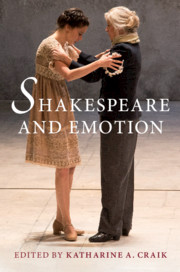Book contents
- Shakespeare and Emotion
- Shakespeare and Emotion
- Copyright page
- Contents
- Figures
- Contributors
- Acknowledgements
- Note on Text
- Introduction
- Part I Contexts
- Chapter 1 Rhetoric
- Chapter 2 Medicine
- Chapter 3 Religion
- Chapter 4 Character
- Chapter 5 Inheritance and Innovation
- Chapter 6 Communities
- Chapter 7 Audiences
- Chapter 8 Acting
- Chapter 9 Bollywood
- Chapter 10 Language
- Chapter 11 Emotional Labour
- Chapter 12 Passionate Shakespeare
- Part II Emotions
- Bibliography
- Index
Chapter 9 - Bollywood
Macbeth, Othello
from Part I - Contexts
Published online by Cambridge University Press: 01 October 2020
- Shakespeare and Emotion
- Shakespeare and Emotion
- Copyright page
- Contents
- Figures
- Contributors
- Acknowledgements
- Note on Text
- Introduction
- Part I Contexts
- Chapter 1 Rhetoric
- Chapter 2 Medicine
- Chapter 3 Religion
- Chapter 4 Character
- Chapter 5 Inheritance and Innovation
- Chapter 6 Communities
- Chapter 7 Audiences
- Chapter 8 Acting
- Chapter 9 Bollywood
- Chapter 10 Language
- Chapter 11 Emotional Labour
- Chapter 12 Passionate Shakespeare
- Part II Emotions
- Bibliography
- Index
Summary
This chapter looks at emotion in Shakespearean cinema by considering two Bollywood adaptations through the lens of Indian aesthetic theory and narrative traditions. Filmmaker Vishal Bhardwaj adapted Macbeth and Othello as Maqbool (2003) and Omkara (2006). Both include a masala mix of genres characteristic of Indian popular cinema (melodrama, romance, tragedy, comedy, gangster film), and both break down the boundaries of genre established in the western narrative tradition by Aristotle. Bhardwaj adapts Shakespearean tragedy into tragic tales of contemporary India that traverse quickly between different Hollywood-defined genres and affective tones, pulling the audience through intense emotional terrain evoked by vivid audio-visual stimuli. Bhardwaj’s work can usefully be approached through the co-ordinates of ancient rasa theory which has dominated aesthetic approaches to the arts in India for over two thousand years. The rasas, or emotions, offer an important lens through which to understand how Indian popular cinema communicates powerfully to its enormous global audience, both resident and diasporic, many of whom are drawn to Bollywood’s emotional intensity and generic hybridity. Rasa theory sheds light on Bhardwaj’s achievement, then, but also provides a valuable and fertile apparatus through which to explore Shakespeare’s works more generally on page, stage, and screen.
- Type
- Chapter
- Information
- Shakespeare and Emotion , pp. 136 - 150Publisher: Cambridge University PressPrint publication year: 2020

